The timsTOF Pro 2 of Bruker is driven by the recent parallel accumulation serial fragmentation (PASEF®) technology and sets the stage for 4D-Multiomics applications. Thanks to its proven high sensitivity, robustness, and fast MS/MS acquisition, timsTOF Pro 2 is the preferred platform for 4D-Metabolomics, 4D-Proteomics, and 4D-Lipidomics.
Highlights
A Quantum Leap in 4D-Omics
- Speed: PASEF® technology attains a >120 Hz sequencing speed without impacting resolution.
- Depth: Extra ion mobility dimension amplifies data completeness.
- Robustness: The unique instrument design facilitates efficient performance and routine operation for thousands of samples without cleaning.
Features
The New Standard for High Speed, High Sensitivity 4D-Multiomics
Liquid chromatography (LC) and mass spectrometry (MS) have turned out to be the gold standard in several omics fields. The coverage of metabolomes or proteomes in complicated biological samples stays difficult owing to current mass spectrometers' limited sensitivity, speed, and resolution.
Including trapped ion mobility spectrometry (TIMS) in the equation reveals the parallel accumulation serial fragmentation (PASEF®) acquisition approach to offer very high MS/MS sensitivity and speed, needing limited sample amounts.
Dual-TIMS and CCS-Enabled Analysis
In the gas phase, TIMS is, first and foremost, a separation technique. This resolves sample complications via an extra dimension of separation, high-performance liquid chromatography (HPLC), and mass spectrometry, which increases confidence and peak capacity in compound characterization.
Equally significant, the TIMS device also gathers and concentrates ions of a given m/z and mobility, facilitating an exclusive increase in speed and sensitivity.
Almost 100% duty cycle can be attained with the dual-TIMS technology enabling accumulation in the front section, whereas ions in the rear section are consecutively released based on mobility. Collisional cross section (CCS) analysis is facilitated by this parallel accumulation serial fragmentation (PASEF®) process.
CCS-enabled analysis paves the path to promote more analytical likelihoods, from higher certainty of compound identification to lower false discovery rates (FDRs) and confident library matching in large datasets.

Image Credit: Bruker Life Sciences Mass Spectrometry
PASEF®
The timsTOF Pro 2 has the innovative dual-TIMS analyzer of Bruker, which provides three times higher ion capacity. Streamlines ion optics increases sensitivity and ion transfer to pave way for the new standard in 4D-Multiomics. PASEF® is a redeveloped MS/MS technology to fulfill the speed necessities of omics applications. Ions are isolated with the use of trapped ion mobility spectrometry, eluted (~100 ms), and found in the quadrupole time of flight (QTOF), producing the TIMS MS heat map.
PASEF® employs the same TIMS separation to fragment ions serially. The quadrupole separates a particular ion species in its elution for MS/MS and instantly shifts to the next precursor. Fragment and parent spectra are aligned using mobility values. The timsTOF Pro 2 can attain a sequencing speed of >120 Hz in PASEF® mode. In addition, the MS/MS spectra quality of low abundant analytes can be augmented by choosing them multiple times.

Image Credit: Bruker Life Sciences Mass Spectrometry
Features
dia-PASEF® Adding Confidence to Identifications
Data-independent acquisition (dia)-PASEF® is both more selective and sensitive than conventional DIA approaches as it implements the PASEF® principle to integrate the benefits of DIA with the integral ion efficiency of PASEF®. Throughout the complete liquid chromatography-mass spectrometry (LC-MS)/MS dia-PASEF® run, an ideal data cuboid is developed comprising m/z, retention time, ion mobility (CCS), and intensity.
TIMS separation improves selectivity, eliminates singly charged precursors from fragmentation, and cleans up the sample by focusing signals from noise. Using the CCS-coded information and correlation of molecular weight from the dual-TIMS funnel, dia-PASEF® allows highly confident identification.
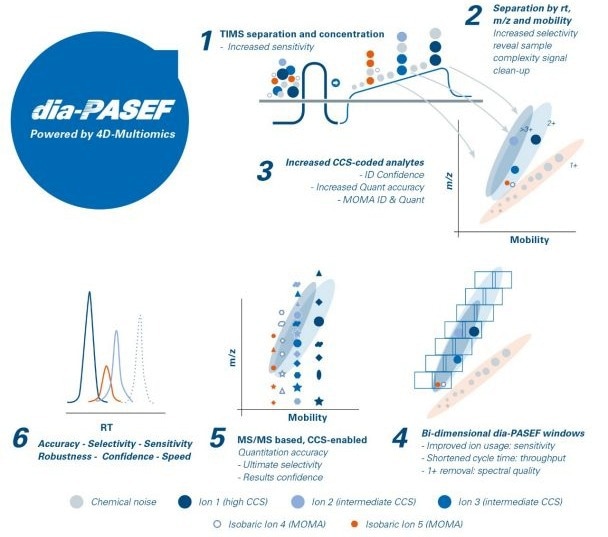
Image Credit: Bruker Life Sciences Mass Spectrometry
Maximize Peptide and Protein Sequence Coverage
The strong stainless steel stacked ring ion guide (SRIG) configuration and optimized standard dia-PASEF® approaches in timsTOF Pro 2 offer an unparalleled depth of proteome coverage in single-shot proteomics. Almost 9000 protein groups were found from 200 ng of K562 lysate in 35-minute gradients (~30 sample/day) with the use of a PepSep 25 cm column with nanoElute on a timsTOF Pro 2 and a TIMScore™ powered spectral library.
For daily cell line proteome, the timsTOF Pro 2 directly provides in-depth proteome coverage quantification experiments by database matching and searching between runs without requiring a spectral library. Varied database search strategies led to very comparable results. PaSER™, facilitating real-time protein identifications, and MaxQuant lead to identical ID numbers at both peptide and protein levels.
K562 digest, 35 minutes gradient (≈ 30 Sample/day) dia-PASEF® analysis of a K562 digest. Data processing was conducted with the use of PaSER™ with TIMS DIA-NN.
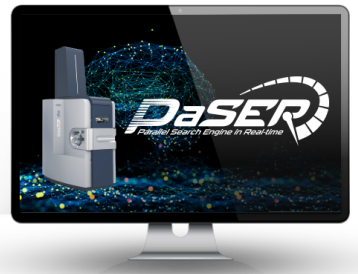
Image Credit: Bruker Life Sciences Mass Spectrometry
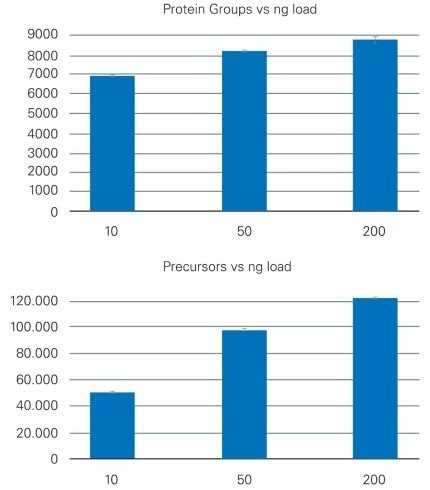
K562 digest, 35 min gradient (≈ 30 Sample per day) dia-PASEF® analysis of a K562 digest. Data processing was performed using PaSER™ with TIMS DIA-NN. Image Credit: Bruker Life Sciences Mass Spectrometry
High-Throughput Targeted Proteomics at Unprecedented Sensitivity
prm-PASEF® benefits from TIMS as a fourth dimension of isolation for unparalleled selectivity, the time-focusing of ions in the TIMS cartridge to improve sensitivity, and the high speed enabled by PASEF® to improve the precursor targets number. Several hundred precursors can be targeted in a single acquisition with no compromise on the high sensitivity and unique selectivity of the timsTOF Pro 2 instrument.
Integrating speed, sensitivity, and selectivity, the prm-PASEF® acquisition method offered precise quantitation and high reproducibility for both a high number of targets and for applications with short chromatography gradients (i.e. <5 minutes).

Targeted proteomics analysis in a colorectal cancer plasma study. 1565 precursors (Heavy/Light) from 565 proteins were targeted in a prm-PASEF® experiment, using Biognosys’s PQ500 kit. Image Credit: Bruker Life Sciences Mass Spectrometry
We’ve been working closely with Bruker to build prm-PASEF® from the ground-up. Throughout our collaboration, we’ve been impressed by the world-class combination of speed, sensitivity, and robustness provided by prm-PASEF®. We are excited to take this performance to the next level on the timsTOF Pro 2.
Jarrod A. Marto, PhD, Associate Professor, Department of Pathology, Brigham and Women’s Hospital and Harvard Medical School, Dana-Farber Cancer Institute, Boston, USA
Applications
Expanding the Horizons with 4D-Metabolomics
Non-targeted metabolomics benefits from high MS/MS coverage as a major component of compound annotation. The optimized 4D-Metabolomics methods of Bruker offer both MS/MS fragmentation spectra and quantitative MS profiling data in the same sample analysis, attaining most of the feature coverage even at low analyte concentrations. PASEF® offers mobility selection before fragmentation leading to clean and unambiguous fragment spectra.
PASEF® can mobility select and fragment all compounds separately, leading to clean fragment spectra. Elimination of matrix-derived MS/MS fragments offers better library matching for Proadifen in MetaboScape® and therefore greater confidence in outcomes.

PASEF® improves MS/MS spectra for better library matching results. Image Credit: Bruker Life Sciences Mass Spectrometry
Higher Confidence with 4D-Lipidomics
Similar to proteomics samples, lipid extracts possess a high sample complexity as a result of the structural diversity of lipids. High-quality MS/MS spectra are essential to achieving confident lipid annotations. CCS-enabled workflows are unlocked by PASEF® and can be utilized to further boost lipid annotation confidence.
Lipidomics data obtained on a timsTOF Pro 2 can be seamlessly examined with MetaboScape®, which exhibits a library-free annotation instrument that uses published fragmentation rules and novel CCS prediction tools. Users can benefit from all four acquired dimensions.
Employing mobility separation, PASEF® can fragment >10× more precursors. This eliminates overlapping contaminants and addresses isomeric and isobaric lipids. The subsequent MS/MS spectra exhibit exclusive fragments for each lipid class leading to annotations with improved confidence.
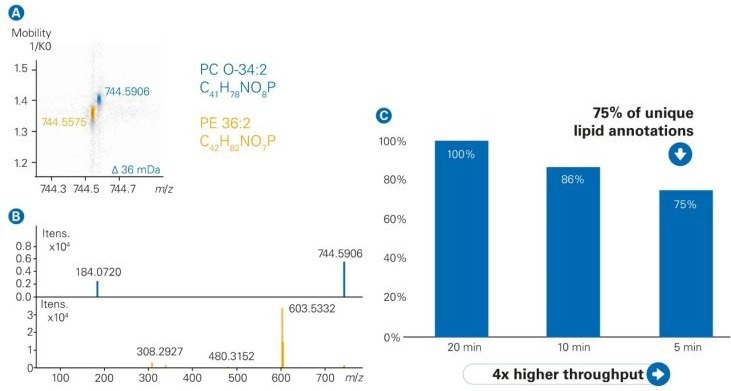
Mobility Offset Mass Aligned (MOMA) data of isobaric lipids (A) Heatmap showing the mobility separation of two isobaric phospholipids co-eluting from reverse phase LC. (B) Clean PASEF® MS/MS spectra after mobility separation. (C) Unique lipid annotations from NIST SRM 1950 (ESI +ve mode) for different gradient run times. Image Credit: Bruker Life Sciences Mass Spectrometry

Image Credit: Bruker Life Sciences Mass Spectrometry
PASEF® already out of the box increases the precursor coverage of lipids with an associated MS2 spectra to 70%. These MS2 spectra are essential for the correct identification of lipids. On top, the use of CCS adds additional confidence in annotation by adding an additional layer of information to RT, MS, and MS/MS.
Dr. Michael Witting, Co-Head Metabolomics and Proteomics Core, Helmholtz Zentrum Munich, Neuherberg, Germany
Ultrahigh-Throughput Confident Screening and Quantification in Complex Matrices
The unparalleled speed of the timsTOF Pro 2 system enables full unknown screening with both GC-APCI and UHPLC VIP-HESI data acquisition. In integration with TASQ® software, Bruker provides a wholesome solution from data acquisition to automated data analysis.
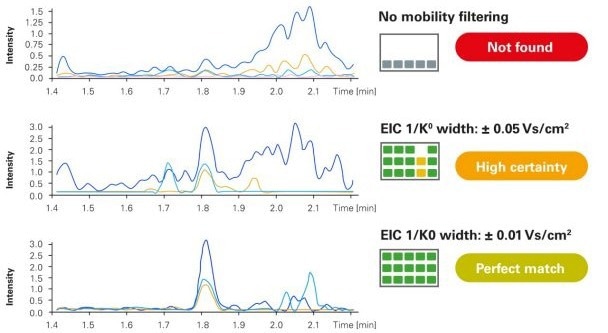
Image Credit: Bruker Life Sciences Mass Spectrometry
Implementing mobility-filtering to extracted ion chromatograms enhances sensitivity in complicated matrices by eliminating interferences. At a concentration of 1 ng/mL, this could be seen clearly in the trace for Thiacloprid in onion. At progressively narrower mobility ranges, the lower traces have been filtered, enabling an ideal match to the TargetScreener database, as highlighted by the green color of the MRSQC score.

Image Credit: Bruker Life Sciences Mass Spectrometry
Extremely High Robustness
Minimal cleaning required
When run for 24 hours/day on large sample cohorts, several MS instruments employed for omics applications need monthly cleaning. Performance degradation can be seen even over shorter durations. The high-grade strength of the timsTOF Pro 2 implies that the instrument can function 24/7 for several weeks with no obvious loss of sensitivity or other performance metrics.
Since we started to work with the timsTOF Pro 26 months ago in February 2019, we have run more than 25000 LCMS samples, of which about 5000 have been non-depleted plasma digests. We had virtually zero downtime so far.
Roman Fischer, PhD, Associate Professor, Clinical Proteomics, Target Discovery Institute, University of Oxford, United Kingdom